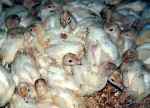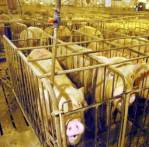Looking at a Past of International News Coverage
December 17, 2009
My interview with the reporter, David Abel, whom I’ve been blogging about this semester.
By Rebecca Ballard
“Sometimes you have to tell a story that’s an important story,” David Abel said, referring to sources he worked with in Cuba who came forward despite risks to their lives. Some people were concerned about having their names published, but others felt free to talk about what was going on. Some of them faced repercussions for that too.
Abel worked in Cuba in 1998, “writing about the regime’s flirtation with capitalism, budding dissident movements and the limits of free expression, and the many ironies 40 years after the revolution, including the regime promoting golf and welcoming u.s. tourists” according to his blog.
Currently though, Abel has moved on to potentially less dangerous territory, but often equally important issues; he covers local news for the Boston Globe, covering issues like “global warming, immigration, homelessness, marriage, labor negotiations, sexual abuse and gun control” (Abel’s Boston Globe Bio).
As a young child, Abel said, he was pretty sure the first thing he ever wanted to be was an airplane. After a brief period of adjustment after learning he could not, in fact, grow up to be an inanimate object, he said he couldn’t decide what he really wanted to do. By college though, he realized being a reporter was his calling—he liked writing, and he wanted to be someone who could hold officials accountable for their actions.
After reporting in Cuba, Abel spent some time working with the military. He was writing for several different papers as he lived in Washington DC, “covering exercises aboard aircraft carriers, the controversy surrounding the navy’s testing range just off Puerto Rico, and arcane issues including problems with submarine warfare and missile defense, the nation’s war strategy, and everything from pork in the defense budget to fraud by contractors” (Military Stories).
This led to him going with troops for 78 days in the spring of 1999 with military troops into the Kosovo War. He said among the challenges he faced was working in a foreign language; he had to worry about whether the information was being translated correctly, or even whether the interpreter might be lying. While the military is notorious in journalism as not being eager to give access, in Kosovo Abel found the American military to be quite helpful and accommodating.
When I asked him how he managed to separate his emotions from his work (considering he was covering the plight of many refugees) he said it was just important to know that while you cared (after all, that’s why you were covering it), it was important to do your best to fully understand the situation and to represent it from a neutral angle in order to be fair (and more effective).
I wondered if he was ever scared, or found himself to be in the sort of danger that made his job as a reporter difficult or even impossible, but while he was in a war zone, Abel said he never felt directly threatened. Except for maybe this one time a train was bombed the week after he’d taken it.
After learning about his international work, and the circumstances if often occurred under, I wondered how he managed to get the sources he did. Naturally, it depended on the source and the story.
Abel told me that it is always important to try to identify where the information comes from, to prove to your readers that it is true. On the other hand, depending on the importance of the information to the article, Abel recommended trying to confirm what you have learned through another source, and then only going ahead with using an anonymous source when necessary.
Windmills of Cuttyhunk Island
December 11, 2009
By Rebecca Ballard
David Abel recently covered the latest development in wind energy debates in New England with his article On Cuttyhunk Island, it’s yes in my backyard.
What I found most interesting of this article was that by simple juxtaposing the opposing viewpoints (when coming from the two different islands), Abel managed to make the residents of the Vineyard who opposed the windmills look like fairly arrogant, self-centered people.
He simply quotes what the two sides say, and describes their situations, however, so really, they do it to themselves. As the reader reads, they are first introduced to the residents of the Vineyard who are for the windmills–while grudgingly admitting it will ruin their view (“they can live with a windfarm”) they also acknowledge that wind energy is necessary and will be beneficial.
Next the reader is introduced to those on the Vineyard who oppose the wind farms. A woman named Barbara Basset states, “If you are successful in barging ahead with this project, you will have managed to destroy one of the few beautiful places left in Massachusetts. Certainly you can find a more appropriate place to locate this project.”
Directly before this statement, a Vineyard resident who is for the windmills has said that while they would prefer not to look at them, they understand that you can’t simply say “not in my backyard” because that just puts it in someone else’s. The quotes in this order make Barbara look self centered because she has just essentially said “let someone else deal with it.”
Finally, the reader meets the residents of Cuttyhunk and learns that could sorely use the financial benefits of a wind farm. When one man states that many Cuttyhunk residents can’t even afford to turn on their air conditioning or heat, this implies that residents of the Vineyard who are against the windmills are so selfish that they would rather “preserve” their view and deprive the Cuttyhunk residents of basic comforts, than have the wind farm.
Personally, I liked the way this article was written, because I think my merely stating the facts, the reader is able to get to the truth of the matter. While I have written that the order leads the reader along in this direction, I believe that ordered another way, similar conclusions could still be deduced, just possibly less efficiently. But maybe that’s just how I read it.
Season’s Bounty Not Getting to the Heart of the Problem
December 6, 2009
By Rebecca Ballard
The other week, David Abel covered the Thanksgiving rush at a local bakery in his article From Verrill Farm ovens, bounty of season’s delights. It was a cute story (and somewhat uplifting, too, which is a nice break from normal news coverage), and it definitely made me want pie, but it didn’t hit issues it could have.
For instance, on the topic of the Thanksgiving holiday I would have liked to see something about the celebrated consumption of turkey. Very little coverage is given to factory farming these days (as if it ever has been) which is unfortunate because in that aspect I think the media is not doing it’s job–spreading awareness about a dangerous issue to the public. Animal rights aside, factory farming presents a huge health risk. Because the animals are kept in such cramped, crowded, and filthy conditions conducive to disease, they have to be consistently and constantly medicated.
According to American Medical News, in 1999 the United States was producing fifty million pounds of antibiotics annually. Of that, “twenty million pounds are given to animals, of which 80% (16 million pounds) is used on livestock merely to promote more rapid growth. The remaining 20% is used to help control the multitude of diseases that occur under such tightly confined conditions, including anemia, influenza, intestinal diseases, mastitis, metritis, orthostasis, and pneumonia.”
When diseases are repeatedly and unnecessarily exposed to antibiotics, they become resistant and the antibiotics cease to be effective. The National Institute of Allergy and Infectious Diseases reported the same year that “the Institute of Medicine at the National Academy of Sciences has estimated the annual cost of treating antibiotic-resistant infections in the U.S. at $30 billion.”
For instance, this can be seen with outbreaks of E.coli. The pH of a cows stomach is neutral–when they graze on their natural diet of grass. However, today to increase how fast a cow grows while decreasing the amount of space they need, cows are raised in cramped dirt feed lots and fed primarily corn (this is also cheap as corn is subsidized by the U.S. government).
Because corn is not natural for cows to eat in mass quantities, their stomach becomes acidic (on a side note, the cows then develop stomach ulcers for which they must be treated with antibiotics). E.coli was origionally only able to survive in neutral stomachs–however, as cows began to consistently have acidic stomachs, E.coli adapted. Thus, the acidic human stomach no longer killed the bacteria and instead we became sickened from eating meat contaminated with it.
While I understand a cow is far from a turkey, the issues created by factory farming on a whole are huge and interconnected–and here with this, I’ve just begun to scrape the surface of one facet (health risk) of the issue (there’s the massive amount of environmental damage, the abuse of factory farm workers, the inhumane treatment of animals such as toe removal and debeaking without anesthesia, the fact that the animals grow so fat so fast their bodies break under them and they can’t walk on their own, etc).
I am also aware that an article about pies being baked is perhaps more appealing to the general public. I just feel that Thanksgiving would have been a good opportunity to raise awareness about factory farming through turkeys and that the mainstream news outlets, or at least the Globe, missed it.
If the animal cruelty side of the state of farming today peaks your interest, I’ve assembled media below that will provide some insight.
Below are just a few images that I have gathered of factory farming conditions (feel free to simply google image “factory farming” or to google that with a certain species to learn more about how your food is raised.
- So-called “free range” turkeys (the same conditions as factory farming minus the cages).
- Factory farmed chickens.
- Factory farmed pigs.
- Factory Farmed Dairy Cows
- “Downer” Dairy Cow
This is an undercover video taken on a dairy farm. While this particular one supplied to Land O’ Lakes, the practices seen in it are absolutely common (again, simply search the internet for plenty more). Just a warning that the below is graphic:
Back to turkeys, the following is an undercover video taken at a hatchery:
Curious what happens when those chicks grow up? An undercover video filmed on one of the World’s largest turkey farms:




